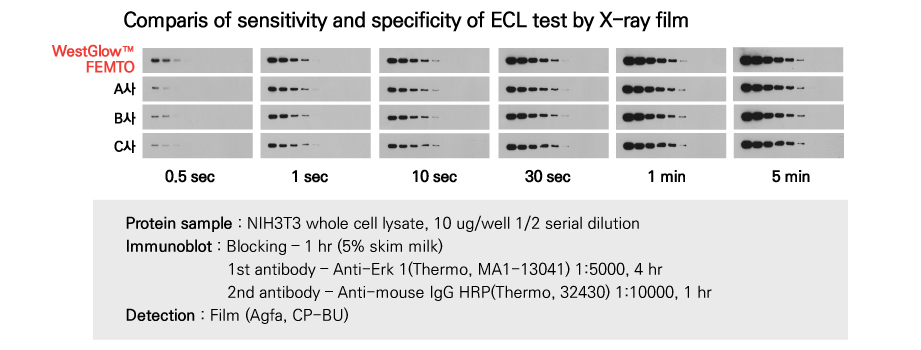WestGlow™ FEMTO ECL Chemiluminescent Substrate
- Home
- Life Science
- WestGlow™ FEMTO ECL Chemiluminescent Substrate
상품 정보
상품 상세설명
Description
Biomax WestGlow™ FEMTO ECL Chemiluminescent Substrate is a highly sensitivity reagent for the detection of proteins and antibodies that are blotted to the membrane. WestGlow™ FEMTO Chemiluminescent Substrate enables detection of low picogram to high femtogram range of protein and it can be used with both digital(LAS, Chemi-doc) and film-based imaging by reacting with horseradish peroxidase(HRP)-conjugated secondary antibody.
Providing the best quality and value in Chemiluminescent western blots
Sensitivity – Mid femtogram to Low femtogram
Duration – 8 hours
Applicable – Digital and X-ray film imaging
Strength – Strong signal with no background

General note
- Depending on the amount of protein, you can change the type of ECL. Use the same blotting condition when changing.
- When performing Western blotting, use a sufficient amount of blocking buffer, washing buffer, and chemiluminescent substrate. If you use too little amount of buffers, the background may go up.
- Do not store the membrane in a buffer containing EDTA or sodium azide. It can interfere to HRP.
- Do not touch the solution with your bare hands. It is recommended that you always use gloves and forceps when touching the membrane.
- Do not bend or hold the membrane hardly.
- Avoid light. In general, chemiluminescent substrates are very vulnerable to light.
Ciatation
2) Ko, S.B., Mihara, E., Park, Y., Roh, K., Kang, C., Takagi, J., Bang, I., and Choi, H.J. (2022). Functional role of the Frizzled linker domain in the Wnt signaling pathway. Commun Biol 5, 421. 10.1038/s42003-022-03370-4.



